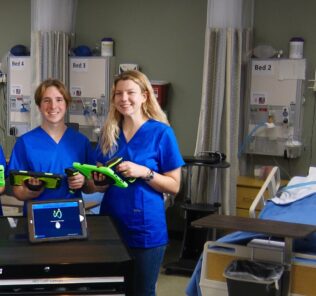Research Update: Clinical Simulation in Nursing | December 2022
The field of healthcare simulation has made tremendous strides forward over the past several decades. One way this revolution is made possible is through clinical simulation research being conducted across the globe. The journal Clinical Simulation in Nursing is constantly sharing updates that include article reviews, more information on standards of best practice, research briefs, and overall innovations in medical simulation. This HealthySimulation.com article provides an overview of the latest clinical simulation highlights and explains how these updates impact the healthcare simulation community.
A Systematic Mapping Literature Review of Ethics in Healthcare Simulation and its Methodological Feasibility: The primary aim of this paper was to systematically map the literature related to ethics in healthcare simulation, guided by the research question, “How is ethics in healthcare simulation recorded in current literature?” The authors’ secondary aim was to explore the feasibility of conducting a systematic mapping review. In doing this, 104 papers were included and analyzed, and the results affirmed that healthcare simulation is a relatively small, but rapidly growing field. Further, the research involved samples of nurses and relied more heavily on qualitative methods and learners in their samples than that on medical doctors or other professions. According to the research, keyword co-occurrence suggested that studies utilized simulation overwhelmingly in an educational context.
Adapting the Use of Mask Ed Simulation in Nursing Programmes During the COVID- 19 Pandemic: In this study, researchers explain that the onset of the COVID-19 pandemic toppled education delivery worldwide, and nursing education was no exception. They add that the pandemic required nurse educators to quickly shift from face-to-face learning environments to remote and more virtual interactions. This meant that educators were compelled to create and employ strategies to support nursing learners as they assimilated critical and complex knowledge, and skills from their homes, instead of classrooms and simulation laboratories. According to the study, one modality of clinical simulation that maintained engagement and connection with learners in the online environment was Mask-Ed Simulation. This paper presents a snapshot of Mask-Ed simulation activities across four higher education institutions globally during the COVID-19 pandemic.
Sponsored Content:
Use of Screen-Based Simulation in Nursing Schools in France: A National, Descriptive Study: In this study, researchers explain that clinical simulation is a major component of undergraduate healthcare training, however, data are lacking regarding simulation modalities used in Europe. Thus, the goal of this national study was to describe how screen-based simulation (SBS) is being used as well as identify the barriers to its use in nursing schools in France. To achieve this, the study employed a descriptive design with 207 nursing schools in France, including deans, heads of schools, and simulation coordinators or leaders who were asked to complete an online survey. Ultimately, although clinical simulation is broadly adopted by nursing schools in France, the authors noted that the use of SBS remains limited.
Simulation Anxiety and its Effect on Clinical Judgment for Undergraduate Nursing Students: According to researchers, high anxiety during simulation has been well documented with calls to reduce students’ anxiety. They explain that simulation anxiety is often assumed to be harmful to learners and a variety of anxiety-reducing interventions have been suggested. The purpose of this study was to explore the effect of different types of anxiety on the clinical judgment of undergraduate nursing students in simulation. The methodology used involved a one-group repeated measure quantitative design using the conceptual framework of Tanner’s (2006) model of clinical judgment.
Decision-Making Errors During Recognizing and Responding to Clinical Deterioration: Gaze Path-Cued Retrospective Think-Aloud: This research shared that using individuals’ own eye gaze path and mouse click tracks has proven to be a valuable technique for identifying a broad range of underlying cognitive processes and lapses of decision-making. Therefore, the researchers aimed to investigate nurses’ decision-making errors in clinical deterioration. They did so using the Tobii Eye Tracker to collect eye movements and mouse clicks of eighteen participants followed by a gaze path retrospective interview.
Describing Learners’ Clinical Judgment Trajectory After Observing Expert Modeling Videos: A Mixed Methods Study: The researchers involved in this clinical simulation study noted that novice nurses have clinical judgment (CJ) deficiencies leading to errors. In response, they wanted to use mixed methods to describe learners’ CJ trajectory after observing eight expert-modeled videos (EM) asynchronously over a semester. They shared that the learners responded to CJ prompts after observing EMs and were scored using Lasater Clinical Judgment Rubric (LCJR). Further, learners were assigned to low, medium, or high-performance groups based on cumulative LCJR rankings. The researchers then analyzed whether background variables related to LCJR scores, and used the Framework Method to describe characteristics of written responses for select low, medium, and high performers.
Sponsored Content:
Evolution of a Simulation Design Template at a Canadian Academic Hospital: In this study, researchers reported that simulation design templates provide a guide for the development, implementation, and evaluation of a simulation scenario. Together, they used the Plan-Do-Study-Act quality improvement framework an open-sourced simulation design template that underwent revisions to become an institution-specific template for use in a corporate nursing orientation program at the Ottawa Hospital in Canada. They concluded that the finalized simulation design template used by the nurse educators at the Ottawa Hospital provided a thorough method for curriculum revision, implementation, and facilitation of simulation-based education sessions.
More About Clinical Simulation in Nursing
Clinical Simulation in Nursing is an international, peer-reviewed journal published online monthly. Clinical Simulation in Nursing is the official journal of the International Nursing Association for Clinical Simulation & Learning (INACSL) and reflects the organization’s mission to advance the science of healthcare simulation.
Articles are indexed in the Science Citation Index Expanded, Journal Citation Reports/Science Edition, Social Science Citation Index, Journal Citation Reports/Social Sciences Edition, and Current Contents/Social and Behavioral Health Sciences. INACSL reviews and accepts articles from other health provider disciplines, if they are determined to be of interest to the INACSL readership. The journal accepts manuscripts meeting one or more of the following criteria:
- Research articles and literature reviews (e.g. systematic, scoping, umbrella, integrative, etc.) about simulation
- Innovative teaching/learning strategies using simulation
- Articles updating guidelines, regulations, and legislative policies that impact simulation
- Leadership for simulation
- Simulation operations
- Clinical and academic uses of simulation
More About INACSL
The International Nursing Association for Clinical and Simulation Learning (INACSL) is an association dedicated to advancing the science of healthcare simulation. With over 1,800 members worldwide, the organization’s mission is to be the global leader in the art and science of healthcare simulation through excellence in nursing education, practice, and research.
INACSL’s goal is also to advance the science of nursing simulation by providing professional development, networking resources, and leadership in defining healthcare simulation standards of best practice. INACSL membership provides the education, resources, and tools that best address current challenges and help support learner, educator, and professional goals related to the learning of healthcare simulation’s latest developments. This is while ensuring that these individuals are enabled to provide the most comprehensive education and training for high-quality patient care.
Whether someone is new to healthcare simulation and is looking to understand the fundamentals or are experienced and seeking the latest updates and research, INACSL can provide them with the support they need. Membership in INACSL is based on connection, engagement, support, and inspiration.
Learn More About Clinical Simulation
Lance Baily, BA, EMT-B, is the Founder / CEO of HealthySimulation.com, which he started in 2010 while serving as the Director of the Nevada System of Higher Education’s Clinical Simulation Center of Las Vegas. Lance also founded SimGHOSTS.org, the world’s only non-profit organization dedicated to supporting professionals operating healthcare simulation technologies. His co-edited Book: “Comprehensive Healthcare Simulation: Operations, Technology, and Innovative Practice” is cited as a key source for professional certification in the industry. Lance’s background also includes serving as a Simulation Technology Specialist for the LA Community College District, EMS fire fighting, Hollywood movie production, rescue diving, and global travel. He and his wife live with their two brilliant daughters and one crazy dachshund in Las Vegas, Nevada.
Sponsored Content:






















